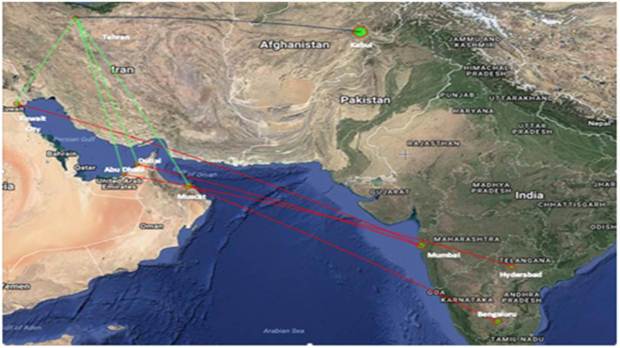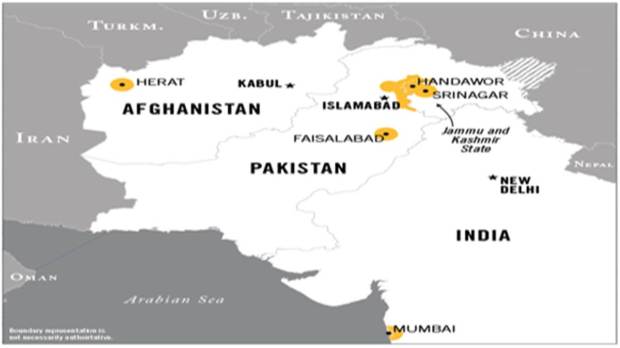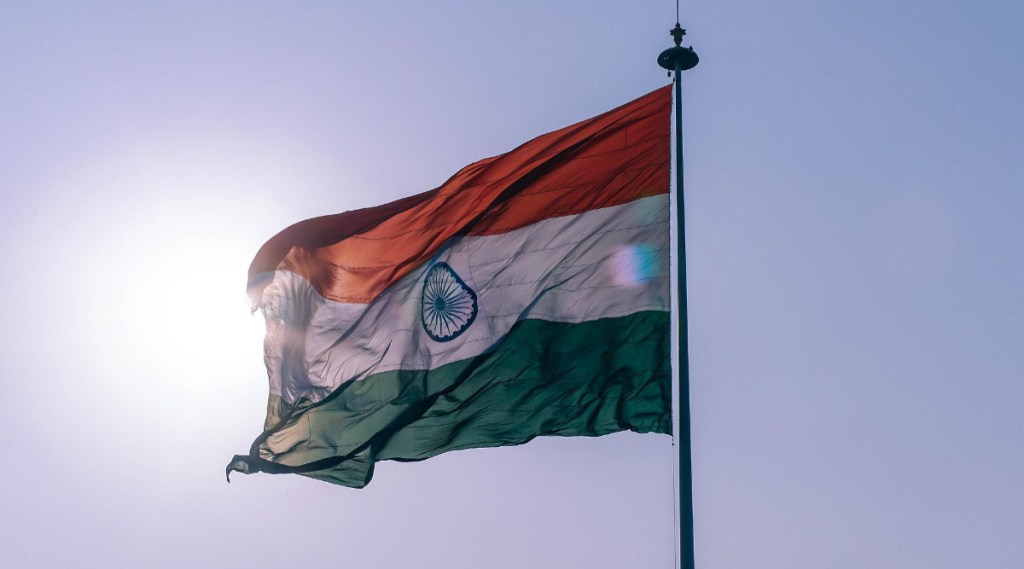By Dr (Prof) Nishakant Ojha
India is equipped to handle both terrorism and targeted violence, making it in a position to offer more than just a strategic framework for fighting terrorism.India has been successful in preventing a large number of its people from leaving the country to engage in combat elsewhere or conduct attacks at home in the aftermath of a retreating Islamic State (IS) and a largely debilitated Al Qaeda (AQ). The efforts of the Indian intelligence agencies, together with opposition from the Indian Muslim population, are largely responsible for this accomplishment.
However, India faces a greater threat from terrorism than only local components that are isolated from the outside world due to cross-border connections with people and organisations that are active abroad. India is looking for effective counterterrorism collaborations as a result of the threat of terrorism’s global reach.
Rising security dangers, notably those related to terrorism, have followed India’s expanding economic ties with the Gulf Cooperation Council (GCC) nations. The following article responds to three inquiries in light of these developments: What are the nature and significance of the international terrorist connections between India and the Gulf Arab nations? What actions has India taken to combat the terrorist threat in coordination with its Gulf Arab allies? What else could be done to improve the counterterrorism (CT) collaboration between India and the Gulf Arab countries?
Time has come for implementing a 5 Eyes Surveillance system with the neighbouring countries where the chances for infiltration is much higher, similar to the alliance in 1946 by the FBI.
Transnational Linkages to Terrorism
The basis for better bilateral ties between India and the six GCC member states was built by the over eight million Indian migrants who worked in the Gulf. Geopolitical upheavals in the late 20th and early 21st centuries were supported by improved ties between India and the United States, which served as a key security provider for Gulf countries, and India’s insatiable want for oil. Gulf Arab-Indian connections A number of declarations and Memorandums of Understanding on commerce, defence, and investments reflect the expanding and deepening of relations between India and Gulf Arab nations. They also included counter terrorism in the area of security.
The Indian Subcontinent (AQIS) at the end of 2014 heightened concerns about Indian citizens’ activity abroad. Three years later, these worries have materialised, albeit in a very modest way; intelligence services have reported that a sizable proportion of Indians who joined the Islamic State had connections to people in the Gulf, where there is a higher danger of radicalization.
In addition, domestic groups like the Indian Mujahideen (IM) and the Student Islamic Movement of India (SIMI) have been hiding in the Gulf even longer than AQ and IS. To lessen the dangers of coordinating with Pakistani citizens across the border to carry out activities, this was done. Terrorists from India have so created a large number of communication networks in the Gulf, which is also home to many Pakistanis. Frequent travel by terrorist organisation members between India/Pakistan and the Gulf countries was not regarded with much suspicion because of the UAE’s sizable immigrant community. Over time, these people have taken use of the economic prospects in the Gulf countries to raise money and/or start enterprises that would subsequently provide financing for operations and information sharing.

Some of known Islamic State cells operating out of the Gulf nations
| Name of IS Cell | Country | Details |
| Ras Al Khaima | UAE | 20-person squad working for the Islamic State |
| Abu Dhabi | UAE | Islamic State recruited nine persons. |
| Bahrain | Bahrain | Activists based in Bahrain who urged followers to visit Syria or Iraq |
Some of prominent Indian terror suspects functional in the Gulf nations
| Country | Name | Role |
| UAE | Dawood Ibrahim | Bomber behind the 1993 Mumbai attacks and an accused in the 2008 Mumbai Taj assault (at large) |
| Saudi Arabia | Abu Jandal | 2008 Taj attack mastermind (deported) |
| Qatar | Mansed bin Mohammed | Recruiter for Islamic State (deported) |
| UAE | Nicky Joseph | Recruiter for Islamic State (deported) |
| UAE | Abudi Wahid Sidibapa | financier for Indian Mujahideen (deported) |
There are many additional ways for India and the Gulf countries to increase their counterterrorism cooperation.
Most of the accused terrorists in open cases were deported to India. India has gradually started to improve its cyber defences to prevent terrorist strikes. These tools are also being used by India to stop radicalization and extremism. For instance, during Operation Chakravyuh in 2014, Indian intelligence agents pretended to be online recruiters for the Islamic State and allegedly discouraged roughly 3,000 adolescents from engaging in terrorist activities. Security officers identified roughly 800 young people thought to be susceptible to internet propaganda during Operation Pigeon Hole, which was carried out in May 2017. They then collaborated with local communities and clerics to deradicalize them.
Based on the effectiveness of these operations, India has provided Malaysia and the Philippines with its knowledge by sending cyber specialists to run training courses for the local security agencies. Similar joint cyber training exercises as well as counter narrative development workshops would be excellent ways for India to further its relations with the Gulf nations.
Another plausible step the countries can take is to convene joint counter terrorism summits with all the members of the Gulf nations. In the short term, due to the ongoing intra-Gulf rift, this may require working with Qatar bilaterally and with the other GCC states as a group. Working along these parallel tracks, India and its Gulf partners could coordinate responses as well as iron out nuances in the respective extradition treaties or develop them in cases where they do not already exist.
Modern civilization’s dynamics are governed by technology, which is a cornerstone of that culture. As a result, it makes sense that terrorists would gain from this. Modern terrorism is immediate and unpredictable, a worldwide threat that strikes its objectives while simultaneously affecting a large audience as a result of technology, and it is entering our homes.
The cyberspace is a limitless environment, a privileged location where terrorists may gather resources, conduct propaganda campaigns, and launch assaults against adversaries anywhere in the globe.
Modern terrorism is not complete without the use of social media, which provides terrorists with effective channels for communication, propaganda production, and supporter recruitment.
Every terrorist attack is similar to a dramatic representation, in which the Internet is the stage.
“Terrorist attacks are regularly & carefully articulate and prepared in sweet box to attract the attention of the electronic media and the international press. Terrorism is aimed at the people watching, not at the actual victims. Terrorism is a theatre”
Although members of the Islamic state use new technologies with great skill, many other terrorist groups use the Internet and its resources every day.
There are a lot of other organisations that are active online, such as Hamas (the Islamic Resistance Movement), the Lebanese Hezbollah (Party of God), the Egyptian Al-Gama’a at Islamiyah, the Kurdish Workers’ Party (PKK), the Zapatista National Liberation Army (ELNZ), the Islamic Movement of Uzbekistan (IMU), the Mujahedin, and the Chechens.
It is quite simple to locate content distributed by terrorist organisations when browsing the Web; a research titled “Terrorism in Cyberspace Time” indicates that the number of terrorists using the Internet has significantly increased.
“12 websites were found to contain terrorist propaganda in 1998, 2,650 were found in 2003, and 18900 were found in September 2021”

Lashkar-e-Tayyiba footprints
One of the biggest and most capable of the terrorist organisations with a focus on Kashmir is Lashkar-e-Tayyiba, also known as the Army of the Righteous. LT was established in the early 1990s as the military branch of Markaz-ud-Dawa-wal-Irshad, an anti-Soviet missionary group located in Pakistan that was created in the 1980s.
Although the precise number of LT members is unknown, the organisation most likely numbers in the thousands and is made up primarily of Pakistanis who want to unify Kashmir under Pakistani sovereignty.
According to al-Qaeda chief Ayman al-Zawahiri, who announced the affiliate’s foundation in a video dated September 3, 2014, another Al-Qaeda in the Indian Subcontinent (AQIS)-AQIS was founded with ISI following a two-year campaign to unite jihadist groups on the Indian Subcontinent. Taliban warriors who support Zawahiri and the Taliban’s current emir, Mullah Mawlawi Haibatullah Akhundzada, who took over in May 2015 after the passing of the Taliban’s previous emir, Mullah Akhtar Mohammad Mansour, are among the group’s members.
Since its independence, India has had to deal with the scourge of terrorism and insurgency. The North-East was the first region affected, then Punjab, and now J&K. Some of the similarities between these motions are shown by an investigation of them. The secessionist movements took place in bordering states or areas, had sponsors or supporters from outside, and had a population composition that was diverse from the core in terms of culture and ethnicity. Compared to the rest of the country, these regions have a mostly minority population. The issue was permitted to be handled by the governments that viewed concerns linked to insurgency and terrorism as law and order issues since it was mostly contained inside state borders. With the resources at their disposal, each state first responded, but quickly allowed the situation to deteriorate. The government has responded to the issue in a variety of harsh and soft ways, but a proactive national policy to provide the counterterrorism system a clear direction has not yet been put into place.
Need for International Consensus to Deal with Terrorism
When insurgencies in India are analysed, the common elements for their growth include violence, widespread support, outside aid, and widespread exposure. Insurgents are also produced when there is a lack of development, jobs, education, and religious tolerance. Due to internal tensions and a lacklustre reaction, external support for terrorists and rebels has been made feasible. The basic basis of the country, “secularism,” is under scrutiny. If all the concerns are handled together and there is agreement to send a clear message to secessionists, the threat to the country may be successfully combated. A democratic system requires agreement on critical topics. India, a secular and democratic nation, cannot effectively combat insurgency without popular backing. All political parties should rise above vote-bank politics and tackle terrorism and insurgency as threats to national security within the boundaries of the constitution and sovereign government.
The complexity and inconsistencies of international politics have been continuously played out when it comes to combating terrorism in India’s neighbourhood, in a setting where member nations’ national interests are weighed equally with the need to preserve an order based on international laws. India has benefited from bilateral and multinational initiatives, particularly in the context of the 26/11 investigations, whether it be through the United Nations or the Financial Action Task Force. The requirements outlined by the Counter Terrorism Committee apply to all UN member nations. In addition, as a signatory to several sectoral conventions on terrorism, India’s own counterterrorism policy—regardless of how it is carried out—is written in the language of UN Security Council resolutions, particularly 1267 and 1373, by including them in the 2008 amendment to the Unlawful Activities Prevention Act, the cornerstone of India’s anti-terror legislation. The amendment provided further detail, referencing, among other things, UNSCRs 1267 that identifies people as terrorists and 1373 that creates the CTC. The UAPA has been modified four times since 9/11, most recently in 2019 to allow the first-ever designation of people as terrorists, drawing on UNSCR 1267. The UAPA, like so many anti-terror legislation across the world, grants the State almost total control over the person, thereby weakening the right to due process. Is today the right time to reconsider the authority that states have ascended to?
However, Delhi must look beyond the current political motivations and propose a framework that reflects its own history of open multilateral engagement, principled diplomacy, rule of law, and constitutional protections when it comes to addressing ideological, racial, and other forms of terrorism. As the United Nations Counter Terrorism Committee undertakes a review of its impact over the last 20 years and charts a course for the future under India’s chairmanship in this unusually important meeting. One of the most important which cannot be ignored when a country is inviting an open business system or the economy upliftment program, the chances of Terrorist infiltration is much more high and can be used as Safe Heaven by them
In the next few years, collaboration will need to be boosted in two specific areas. Afghanistan is the first. Maintaining intelligence capabilities in Afghanistan to gather data on Al Qaeda, LeT, and other terror groups operating in Afghanistan and the Pakistani border regions will become more challenging as NATO soldiers withdraw from the country. India has already boosted its capabilities there and has established strong connections with the Afghan government. The United States should encourage this collaboration and make efforts to cooperate with Afghanistan and India as well as the need for an alliance-wide counterterrorism task force. Countries, the urgent necessity.
Pakistan is the second. The army and the ISI continue to have strong ties to other terrorist organisations, including LeT, even though Pakistan has adopted a more assertive stance against its own Taliban militancy this year. Strong intelligence exchange on Pakistan’s terrorist linkages, notably the ISI-LeT nexus, should be part of counterterrorism collaboration with India.
The more that can be done to stop such a catastrophe, the better. Another LeT assault, similar to those in Mumbai or Herat, will lead to the most serious crisis between India and Pakistan in years. Even if an attack cannot be prevented, the more details shared concerning Pakistani ties to LeT, the more likely it is that the U.S. will be taken seriously by New Delhi in the event of a crisis.
Additionally, the US should think about taking a unilateral action by adding Pakistan to the State Department’s list of nations that support terrorism. It clearly satisfies the requirements and has for many years. In 1992, the first Bush administration gave this idea some serious thought. Clearly, such a move would have a significant impact on ties between the United States and Pakistan. Targeting particular sanctions on specific Pakistani officials implicated in aiding terrorism, such as members of the ISI’s “S” branch, which manages liaison with the LeT, the Haqqani network, and others, would be a more constrained course of action.
The Pakistani army would get a powerful deterrent message from targeted counterterrorism penalties on particular Pakistani government leaders, and this might serve as a preemptive warning before adding Pakistan to the list of states that support terrorism. Last but not least, Washington and New Delhi should coordinate their contingency plans for handling a future India-Pakistan crisis akin to the Kargil conflict or the crisis of 2001–2002. Instead of planning to gang up on Pakistan, this would be done to start a conversation about crisis management.
Working on technologies is one of the most important areas to focus on since current terrorism is immediate and unexpected, a worldwide danger that strikes its targets while also affecting a large audience as a result of technology, which is bringing the fear into our homes.
The cyberspace is a limitless environment, a privileged location where terrorists gather resources, carry out propaganda operations, and from which it is possible to launch assaults on adversaries anywhere in the globe.
In terms of counterterrorism, India’s situational environment differs slightly from that of the US. India is a regional power, whereas the US is the global hegemon. India, unlike the US, is not in a position to define the normative construct of the enemy or the methods to combat them while being the greatest democracy in the world with increasing global impact. As a result, it supports a rigid conception of terrorists and terrorism. The concept of “Islamist” terrorism, which derives from the ongoing struggle in and over Kashmir, as well as incidents linked to Pakistani state-sponsored infiltration of terrorists, continue to be dominant threats in India’s security calculation.
Also in part we can see radicalization continuing in immigrant populations’ youth & alienated minorities in Europe, the Middle East & Africa. It is clear that radicalization does not occur by incident but specifically with grievances of alienated youth or immigrant populations and then cynically exploiting those grievances to subvert legitimate authority and create instability or unrest.
Author is Eminent Expert –Counter Terrorism (West Asia & Middle East).
Disclaimer: Views expressed are personal and do not reflect the official position or policy of Financial Express Online. Reproducing this content without permission is prohibited.
